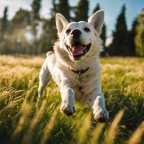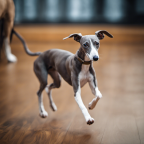- Key Takeaways
- The Importance of Teaching Your Dog to Jump
- How to Start Training Your Dog to Jump
- Step-by-Step Guide to Teaching 'Salta
- Common Mistakes to Avoid When Teaching Your Dog to Jump
- Fun Activities to Incorporate 'Salta' Into Your Dog's Routine
- Taking 'Salta' to the Next Level: Advanced Jumping Techniques
Click and GO TO THE BEST DOG NAME GENERATOR HERE
Ready to take your dog’s training to new heights?
In this article, we’ll show you the importance of teaching your furry friend to jump using the Italian command ‘Salta.’
Whether you’re a beginner or an experienced trainer, we’ve got you covered with a step-by-step guide, common mistakes to avoid, and fun activities to incorporate ‘Salta’ into your dog’s routine.
Get ready to elevate your dog’s skills and have some jumping fun along the way!
- Key Takeaways
- The Importance of Teaching Your Dog to Jump
- How to Start Training Your Dog to Jump
- Step-by-Step Guide to Teaching 'Salta
- Common Mistakes to Avoid When Teaching Your Dog to Jump
- Fun Activities to Incorporate 'Salta' Into Your Dog's Routine
- Taking 'Salta' to the Next Level: Advanced Jumping Techniques
Key Takeaways
- Teaching your dog to jump has numerous benefits for their physical health and agility.
- Training your dog to jump involves using positive reinforcement and gradually increasing the difficulty of the obstacle.
- Building jumping confidence increases your dog’s agility, coordination, and obedience.
- Fun activities like creating indoor and outdoor agility courses can help practice jumping skills while keeping your dog active and entertained.
The Importance of Teaching Your Dog to Jump
If you want your dog to excel in agility competitions, it’s important that you teach them to jump. Jumping isn’t just a fun trick, but it also has numerous benefits for your dog’s physical health and agility.
By incorporating jumping exercises into your dog’s daily exercise routine, you can provide them with mental stimulation and release their excess energy.
Teaching your dog to jump helps improve their overall physical health. Jumping exercises strengthen their muscles, including their leg and core muscles. It also improves their cardiovascular fitness and endurance. Regular jumping exercises can enhance their flexibility and coordination, making them more agile and less prone to injuries. Additionally, jumping can help maintain a healthy weight for your dog, reducing the risk of obesity-related health issues.
Incorporating jumping exercises into your dog’s daily exercise routine is also essential for their mental stimulation and energy release. Dogs are naturally energetic animals, and if they don’t have an outlet for their energy, they can become bored and develop behavioral issues. Jumping exercises require focus and concentration, challenging their minds and keeping them engaged. It also provides an opportunity for them to release their pent-up energy in a controlled and constructive way.
How to Start Training Your Dog to Jump
To start training your dog to jump, begin by choosing a suitable jumping obstacle, such as a low hurdle or a raised platform.
Use positive reinforcement, such as treats or praise, to encourage your dog to approach and jump over the obstacle.
Gradually increase the height or difficulty of the obstacle as your dog becomes more confident and proficient in their jumping technique.
Jumping Technique Tips
You can improve your jumping technique by practicing landing softly on your toes. This technique helps absorb the impact and prevent jumping-related injuries.
Here are some tips to enhance your jumping skills:
- Strengthen your leg muscles through exercises like squats and lunges, which will give you more power and stability.
- Incorporate plyometric exercises like box jumps and jump squats to increase your explosive power.
- Practice proper form by keeping your knees slightly bent, arms extended for balance, and eyes focused ahead.
- Warm up before jumping exercises to increase blood flow and flexibility.
- Gradually increase the height and intensity of your jumps to challenge yourself and improve your vertical leap.
- Don’t forget to cool down and stretch after your jumping workouts to prevent muscle tightness and reduce the risk of injuries.
Building Jumping Confidence
Practice jumping exercises with your dog and gradually increase the height of the jumps to build their confidence. Building jumping confidence is essential for dogs, especially those who may have a fear of jumping. By starting with low jumps and gradually increasing the height, you can help your dog overcome their fear and develop the necessary skills for successful jumps.
To further understand the importance of building jumping confidence, take a look at the table below:
| Benefits of Building Jumping Confidence | How It Helps Your Dog | Tips for Overcoming Fear of Jumping |
|---|---|---|
| Increases agility and coordination | Builds trust | Start with small obstacles |
| Boosts self-esteem and confidence | Enhances obedience | Use positive reinforcement |
| Strengthens bond between dog and owner | Provides mental stimulation | Gradually increase the difficulty |
Step-by-Step Guide to Teaching ‘Salta
Jumping can be taught to your dog using a step-by-step guide. It’s a great way to incorporate jumping into your dog’s exercise routine and teach them to jump over obstacles. Here’s a detailed guide to help you teach your dog the command ‘Salta’ (which means ‘Jump’ in Italian) like a pro:
-
Start with basic obedience training: Before teaching your dog to jump, make sure they’ve a solid foundation in basic obedience commands like sit, stay, and come. This will help them understand and follow instructions better.
-
Introduce the concept of jumping: Begin by using a low obstacle like a broomstick or a small hurdle. Encourage your dog to jump over it by using treats or a favorite toy as motivation.
- Use positive reinforcement: Reward your dog with treats and praise each time they successfully jump over the obstacle.
- Gradually increase the height: Once your dog is comfortable jumping over the low obstacle, gradually increase the height to challenge them and improve their jumping ability.
- Practice regularly: Consistency is key when teaching your dog any new command. Set aside dedicated training sessions to practice jumping with your dog, gradually increasing the difficulty of the obstacles.
Common Mistakes to Avoid When Teaching Your Dog to Jump
While teaching your dog to jump, it’s important to avoid rushing the process and ensure that they’ve a solid foundation in basic obedience commands. One of the most common mistakes is trying to progress too quickly without giving your dog enough time to build confidence and understand the jump command. It’s crucial to start with low obstacles and gradually increase the height as your dog becomes more comfortable.
Another mistake isn’t properly tracking your dog’s training progress. Keeping a record of each training session allows you to monitor your dog’s improvement and identify any areas that need extra attention. This will help you adjust your training methods accordingly and ensure a successful outcome.
By avoiding these common mistakes and taking the time to track your dog’s progress, you’ll create a strong foundation for teaching your dog to jump.
Now that your dog has mastered the ‘salta’ command, it’s time to have some fun and incorporate it into their routine. Jumping can be incorporated into various activities such as agility courses, fetch games, or even simple obstacle courses in your backyard. These activities not only provide mental and physical stimulation for your dog but also reinforce their obedience and jumping skills.
Remember to always prioritize safety, and gradually increase the difficulty level as your dog becomes more proficient. By making jumping a regular part of your dog’s routine, you can continue to strengthen their skills and create a bond based on trust and cooperation.
Fun Activities to Incorporate ‘Salta’ Into Your Dog’s Routine
Looking for fun activities to incorporate ‘salta’ into your dog’s routine?
Create an indoor agility course using everyday household items like chairs, tunnels, and hula hoops.
Set up an outdoor obstacle course with items like cones, jumps, and balance beams.
These activities will help your dog practice their jumping skills while keeping them active and entertained.
Indoor Agility Course
You can navigate the indoor agility course with your dog, improving their agility skills and reinforcing the command ‘salta.’ Indoor agility competitions are a great way to showcase your dog’s abilities and compete against other talented teams.
Here are some benefits of indoor agility training:
- Physical exercise: The course requires your dog to jump, weave through poles, and navigate obstacles, providing a full-body workout.
- Mental stimulation: Your dog will need to think quickly and problem-solve to complete the course successfully.
- Bonding opportunities: Working together on the course strengthens the bond between you and your dog.
- Confidence building: As your dog masters each obstacle, their confidence grows, leading to increased self-assurance in everyday life.
- Competition preparation: Indoor agility training prepares your dog for future competitions, allowing them to perform at their best when it matters most.
Outdoor Obstacle Course
Go outside and practice ‘salta’ with your dog on the outdoor obstacle course, jumping over logs and climbing through tunnels. Dog park games like these aren’t only fun for your furry friend, but also provide great mental and physical stimulation.
However, it’s essential to take safety precautions to ensure a safe and enjoyable experience for both you and your dog. Firstly, make sure the obstacle course is secure and free from any potential hazards. Keep an eye on your dog’s energy levels to prevent them from overexerting themselves.
It’s also important to monitor their behavior and reactions during the game to ensure they’re comfortable and not showing signs of distress. Remember to always reward and praise your dog for their efforts, creating a positive and rewarding experience for them.
With the right precautions, dog park games can be a fantastic way to bond with your pet and keep them happy and healthy.
Taking ‘Salta’ to the Next Level: Advanced Jumping Techniques
Try out these new techniques to elevate your ‘Salta’ jumps to the next level. If you’re looking to challenge your furry friend and improve their jumping skills, incorporating advanced jumping exercises into your daily walks is the way to go.
Here are some tips to help you take your dog’s ‘Salta’ to the next level:
-
Utilize natural obstacles: Look for fallen logs, rocks, or low walls during your walks. Encourage your dog to jump over these obstacles, gradually increasing the height and difficulty as they progress.
-
Set up a mini agility course: Create a mini agility course in your backyard or a local park using cones, hurdles, and tunnels. Guide your dog through the course, incorporating various jumping exercises such as long jumps or weaving through poles.
-
Try different surfaces: Vary the surface your dog jumps on to challenge their balance and coordination. Incorporate jumping exercises on grass, sand, or even on cushions to add an extra level of difficulty.
-
Use positive reinforcement: Reward your dog with treats and praise when they successfully complete a jump. Positive reinforcement will motivate them to continue improving and give their best effort.
- Key Takeaways
- The Importance of Teaching Your Dog to Jump
- How to Start Training Your Dog to Jump
- Step-by-Step Guide to Teaching 'Salta
- Common Mistakes to Avoid When Teaching Your Dog to Jump
- Fun Activities to Incorporate 'Salta' Into Your Dog's Routine
- Taking 'Salta' to the Next Level: Advanced Jumping Techniques


